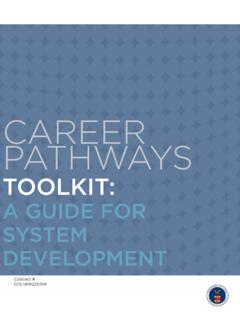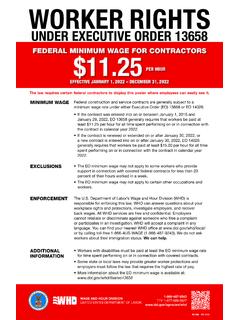Transcription of A Quick-Start Toolkit - Employment and Training …
1 Building Registered Apprenticeship Programs A Quick-Start Toolkit Apprenticeship Toolkit 2 What do a computer programmer, an electrician, an office manager, a home health aide, and a wind turbine technician all have in common? They are all jobs that can be learned through an apprenticeship. While 75 years ago the apprenticeship system started in construction and other skilled trades, today there are apprenticeships in over 1,000 occupations including careers in Healthcare, Information Technology, Advanced Manufacturing , Transportation and Logistics, and Energy. Toolkit This Toolkit provides helpful steps and resources to start and register an apprenticeship program, from exploring the apprenticeship model as a workforce strategy to launching a new program. Whether you re a business or labor organization, an industry association or another kind of workforce intermediary, a community college or the public workforce system, or a community-based or service organization, we invite you to use this Toolkit 1 Explore Explore apprenticeship as a strategy to meet your needs for skilled workers 2 Partner Partner with key players in your region to develop an apprenticeship program 3 Build Build the core components of your apprenticeship program 4 Register Apprenticeship Registered Apprenticeship is a tried-and-true approach for preparing workers for jobs and meeting the business needs for a highly-skilled workforce that continues to innovate and adapt to meet the needs of the 21st century.
2 Businesses that use apprenticeship reduceworker turnover by fostering greater employeeloyalty, increasing productivity, and improvingthe bottom line. Apprenticeships offer workers a way to start newcareers with good wages. Workforce organizations, community colleges,and other education and Training institutions canuse apprenticeship as a proven Employment andRegister your program to join the apprenticeship network Launch Launch your new Registered Apprenticeship program Training Apprenticeship Toolkit3 apprenticeship as a strategy to meet your needs for skilled workers. Registered Apprenticeship is an employer-driven model that combines on-the-job learning with related classroom instruction that increases an apprentice s skill level and wages. It is a proven solution for businesses to recruit, train, and retain highly skilled workers. Apprenticeship is not just for the private sector many federal government agencies, including the military, have apprenticeship programs.
3 Apprenticeship is a flexible Training strategy that can be customized to meet the needs of every business. It can be integrated into current Training and human resource development strategies. Apprentices can be new hires or businesses can select current employees to join the apprenticeship program. Apprenticeships are a good way to reward high-performing entry-level employees and move them up the career ladder within the business. Apprenticeship is also an earn and learn model apprentices receive a paycheck from day one, so they earn wages while they learn on the job. More than 500,000 apprentices participate in Registered Apprenticeship programs across the country. Benefits. Benefits for Benefits for Workforce Intermediaries and Education Highly-skilled Reduced turnover costs Higher productivity Proven model to help job seekers More diverse workforceimmediately start working andincrease skills and earningsBenefits for Effective strategy to connect withemployers in diverse fields and Increased skillsto use as part of industry sector Higher wagesstrategies National credential Career advancement Apprenticeship Toolkit 4 Question Whether you are a growing business, a workforce intermediary helping employers build a skilled workforce, or a community college educating the local workforce, what workforce challenges have you identified?
4 Jobs for which it is difficult to find workers with the right skills? Positions with high turnover? Occupations where a highly skilled workforce is retiring soon? Challenges helping workers keep pace with continuing industry advances? Positions requiring skills that can be learned on the job? Difficulty in attracting new and more diverse talent pools?If the answer is yes to any of these questions, then apprenticeship is the right strategy to meet your needs for skilled workers. UPS UPS uses Registered Apprenticeship to train delivery drivers. The company s Training processes are varied and comprehensive, and the apprenticeship program provides workers with valuable skills that will help them succeed in the long term. By having a Registered Apprenticeship program, UPS sends a clear message to job seekers that they will receive quality Training and that the company has the tools to help them learn and advance. UPS has pledged to send 2,000 people through its program by 2018 who will work in package delivery, operations, and automotive repair.
5 Read more about the UPS partnership with Registered Apprenticeship To further explore Registered Apprenticeship as a workforce Listen to Testimonials about the value of apprenticeship Read the Solutions for Industry fact sheet Review the list of Apprenticeable Occupations Review the Frequently Asked Questions on Registered ApprenticeshipApprenticeship Toolkit5 with key players in your region to develop an apprenticeship. Are you ready to start developing an apprenticeship program? Don t go it alone! Successful apprenticeships are born from collaboration among partners businesses, workforce intermediaries (such as industry associations or labor organizations), educational institutions, the public workforce system, and other key community organizations. The partnership works together to identify the resources needed, design the apprenticeship program, and recruit apprentices. Apprenticeship Toolkit Employers WORKFORCE SYSTEM COMMUNITY ORGANIZATIONS ECONOMIC DEVELOPMENT LOCAL EDUCATION (K-12) S TAT E APPRENTICESHIP AGENCIES FOUNDATIONS LABOR ORGANIZATIONS COMMUNITY COLLEGES Possible Apprenticeship Partners Every partner has a critical role to play.
6 Business Partners (individual company, consortium of businesses) Identify the skills and knowledge that apprentices must learn Hire new workers, or select current employees, to be apprentices Provide on-the-job Training Identify an experienced mentor to work with apprentices Pay progressively higher wages as skills increase Can provide related instruction in-house or in partnership with othersWorkforce Intermediaries (industry association, labor and joint labor-management organization,community-based organization) Provide industry and/or workforce specific expertise ( curriculum development) to support employers in a particularindustry sector Can serve as sponsor of an apprenticeship program, taking responsibility for the administration of the program (therebyreducing the burden on employers) Aggregate demand for apprentices, particularly with small- and medium-size employers, that may not have the capacityto develop an apprenticeship program on their own Can be the provider of related instruction and supportive services as appropriateEducational Institutions (4-year college, community college, career and technical education) Develop curriculum for related instruction Deliver related instruction to apprentices Can provide college credit for courses successfully completed Aggregate demand for apprentices6 Apprenticeship Toolkit 7 Public Workforce System (Workforce Development Board, American Job Center) Develop sector and career pathway strategies utilizing apprenticeship Recruit and screen candidates to be apprentices Provide pre-apprenticeship and basic skills preparation Provide supportive services (such as tools, uniforms, equipment, or books)
7 Contribute funding for on-the-job Training or related instructionApprenticeship System (State office of apprenticeship) Provide technical assistance and support to new sponsors Answer questions about the apprenticeship model Guide the partners through the steps to develop and register a program Connect businesses with Training providers Advise partners on sources of funding to support apprenticeshipsOther partners play important roles too! For example, economic development organizations can serve as a convener of businesses in the region. The K-12 educational system can help develop pipelines to apprenticeship for students. Community-based organizations may have capacity to help certain worker populations, such as women, veterans, minorities, individuals with disabilities, and others, prepare for apprenticeships and provide supportive services to apprentices. Every Registered Apprenticeship program has a sponsor. The sponsor is responsible for the overall operation of the program, working in collaboration with the partners.
8 Sponsors can be a single business or a consortium of businesses. Alternatively, the sponsor can be a range of workforce intermediaries including an industry association or a joint labor-management organization. Community colleges and community-based organizations can also serve as sponsors for Registered Apprenticeship programs. To learn more about apprenticeship partnerships and connect with partners in your Find the apprenticeship contact in your state using the directory of state apprenticeship offices For national employers, contact the Department of Labor s Office of Apprenticeship at(202) 693-2796 or via e-mail at Find and contact workforce investment boards and community colleges in your region by visitingAmerica's Service LocatorApprenticeship in the Energy AEP has had a distribution line apprentice program for over 40 years. The apprenticeship program sets the foundation for our field line mechanics to be able to evaluate a wide variety of field conditions so that a safe work plan can be developed and carried out to meet the challenging demands of the electric utility industry.
9 " - Debra Nobels, American Electric Power Apprenticeship Toolkit 8 the core components of your apprenticeship program. With a strong partnership in place, the next step is to design and build your apprenticeship program. Apprenticeship programs consist of five core components: direct business involvement, on-the-job Training , related instruction, rewards for skill gains, and completion resulting in a national occupation credential. For each, the partners will develop the details of that component, leverage the resources needed, and decide which partners will carry out that part of the program. Apprenticeship Toolkit 9 Components BUSINESS INVOLVEMENT Employers are the foundation of every Registered Apprenticeship program. 0102030504 What are the Components of Registered Apprenticeship? STRUCTURED ON-THE-JOB Training Apprentices receive on-the-job Training from an experienced mentor for typically not less than one year.
10 RELATED INSTRUCTION Apprenticeships combine on-the-joblearning with technical education atcommunity colleges, technical schools,apprenticeship Training schools,provided on-line or at the job site. REWARDS FOR SKILL GAINS Apprentices receive increases in wages as they gain higher level skills. NATIONAL OCCUPATIONAL CREDENTIAL Registered Apprenticeship programs result in anationally-recognizedcredential a 100% guarantee to employersthat apprentices arefully qualified forthe job. Business Involvement. Employers are the foundation of every apprenticeship program and the skills needed by their workforce are at the core. Businesses must play an active role in building the program and be involved in every step in designing the apprenticeship. Apprenticeship Toolkit 10 On-the-Job Training . Every program includes structured on-the-job Training . Apprentices get hands-on Training from an experienced mentor at the job site for typically not less than one year.













